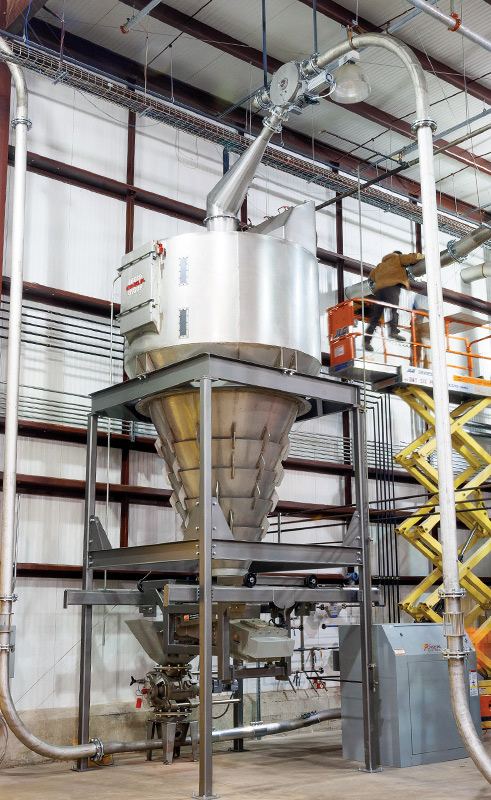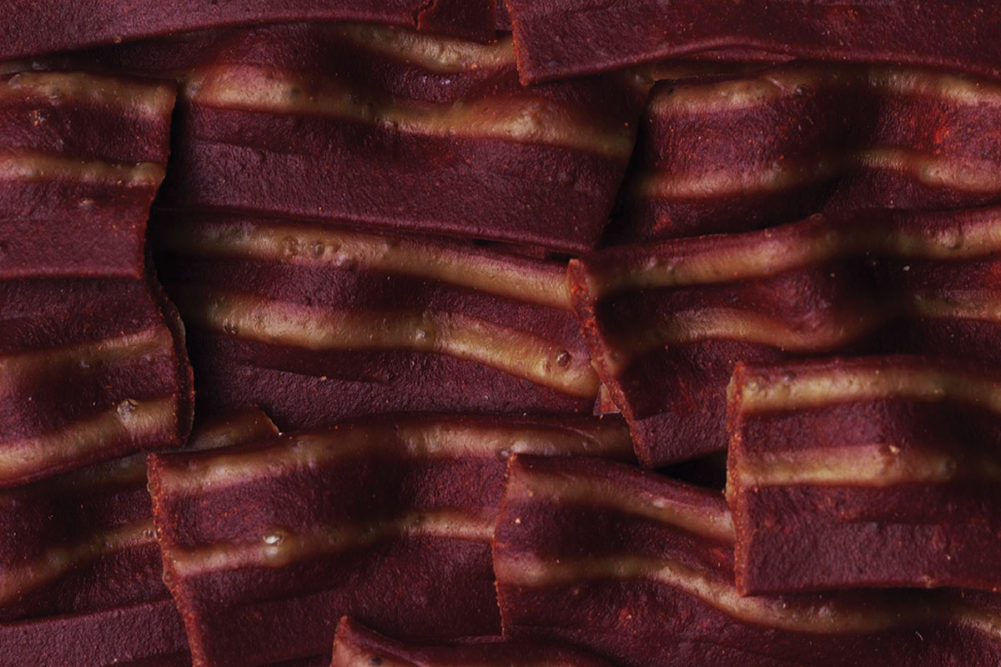This article was published in the September 2020 issue of Pet Food Processing. Read it and other articles from this issue in our September digital edition.
Cooling is a critical step in many pet food and treat processing applications that removes unwanted heat from the product. It is used to control product temperature before further processing steps, or prior to final storage or packaging. Using modern technology, processors are able to cool product to desirable levels without sacrificing product safety, quality or integrity.
“Cooling is an important piece to get right, maybe even an underrated piece of the pet food production puzzle,” said Daniel Tramp, technical sales, companion animal division, Wenger Manufacturing Inc., Sabetha, Kan. “Improper cooling can lead to issues that directly affect product quality and the customer experience.”
“Improper cooling can lead to issues that directly affect product quality and the customer experience,” said Daniel Tramp, Wenger Manufacturing Inc.
Tom Barber, vice president, capital equipment and process engineering, Bühler Aeroglide Corporation, Cary, N.C., agreed on the importance of cooling in the processing of pet food and treats.
“Cooling is a critical point in processing pet food,” he said. “A product must heat and cool at a set temperature within an appropriate time period to achieve the desired product characteristics, to become safe for consumption, and to be packaged for shelf stability.”
Cooling options
Cooling options utilized by pet food and treat processors depend largely on the characteristics of the product.
“There are numerous options for cooling, depending on what the manufacturer is trying to cool,” explained David Wangensteen, vice president, XChanger Inc., Hopkins, Minn.
The company manufacturers air-cooled and liquid-cooled heat exchangers that are designed to cool air used in the manufacturing process. The cool air can then be used to lower the temperature of pet food or treats.
“We have two different air-cooled heat exchangers,” Wangensteen said. “Our most common, the AA-Series, is designed to use ambient air to cool process air. The other, the LC-Series, uses ambient air to cool process liquid. These heat exchangers offer low pressure loss on the process side and only require electricity to run the motor, so are fairly easy to install. They do reject all of the heat removed from the process air or liquid into the atmosphere, so must be installed outdoors or in a well-ventilated space. Their cooling ability is limited by the ambient air temperature.
“Xchanger’s liquid-cooled air cooler, the C-Series, uses cool liquid (water, glycol/water mixture, etc.) to cool process air,” he continued. “These heat exchangers also offer low pressure loss on the process air side. A supply of cool liquid is required. The cooling water is most often supplied from a cooling tower or chiller, depending on the required temperature of the coolant.”
A variety of options are also available to cool pet food and treats directly.
“There are four primary means of pet food/treat production cooling,” said Adrian Martinez-Kawas, international project manager, Corporate Project Services, a division of Wenger. “Continuous flow vertical cooling, counterflow vertical cooling, continuous flow belt cooling, and continuous batch open air cooling.”

“For most companion animal food products, a simple single-pass horizontal or vertical cooler is sufficient,” Henry said. “Treat products often require a more tailored solution driven by extrusion process profile, raw material matrix and desired finished product specifications. For 90% of the market (by volume), simple and cost-effective [process utilities] provide the gold standard.”
In kibble production, the primary cooling step occurs after the product is coated. However, there is often a pre-coating cooling step that also plays an important role.
“This step is designed to create the best conditions for absorption of liquids into the kibble,” Martinez-Kawas explained. “Typically, target optimal kibble temperatures are 50 C to 60 C for the coating step when using atmospheric coating and 40 C to 50 C for vacuum coating. Higher temperatures can run the risk of triggering condensation in the coating step, which can lead to scenarios that support microbial growth and product spoiling. Additionally, for some specialty goods a pre-cutting cooling step is needed. Often in the case of long goods that are extruded in a rope fashion, some cooling time is needed in order to ensure consistent and correct cutting. This is typically done on a belt cooling device.”
Ultimately, a number of factors must be taken into consideration when deciding on the best way to cool pet food and treat products.
“The ideal cooler configuration depends upon several variables, including the manufacturing process, the space available in the manufacturing plant, source of cooling air, desired final product temperature, degree of process control required, and the investment and operating cost of the cooler,” Barber remarked.
Addressing cooling challenges
Food safety is one of the major challenges related to cooling pet food and treats.
“The primary goal of cooling is to uniformly lower the product temperature within a target delta of 5 C to the ambient temperature of the packaging and warehouse storage areas so as to avoid condensation, or ‘sweating,’ of the product within the package, which would in turn support scenarios for microbial growth and product spoiling,” Tramp said. “Two of the main challenges for reaching this goal include that of consistent cooling of the product as well as total cooling abilities. Meaning having all product cooled to the same temperatures with no hot spots as well as actually achieving the temperatures desired in the total cooling process.”
In addition to product “sweating,” improperly sanitized cooling equipment can lead to food safety issues.
“Soon after separate coolers evolved, the need for improved sanitation surfaced,” Barber said. “When hot, fats and oil materials are fairly fluid. But once cooled, they congeal. Excess enrobing material tends to coat the interior surfaces of the cooler, forming a difficult-to-clean substance that is normally not soluble in water. If machinery isn’t thoroughly cleaned and sanitized, there is the risk of product contamination.”
In answer to the challenge of maintaining food safety, manufacturers of cooling equipment are focusing on hygienic design.
“Carefully designed hygienic equipment not only reduces the risk of contamination — and thereby, minimizes the possibility of costly product recalls — it also maintains product quality, increases productivity, and contributes to sustainability,” Barber commented.
Bühler’s Solis multi-pass pet food dryer has an open channel frame, sloped surfaces, and a floor designed to reduce the ability for fines to collect and harbor bacterial growth. The cooler has been removed from the interior of the dryer enclosure and deployed as an externally extended cooler to guard against the bacterial problems associated with condensation and fines buildup.
Another challenge for processors is the nature of the materials used in pet food and treat production.

“The biggest challenge comes from the highly viscous nature of meat slurries, pet food, and similar materials,” said Matt Hale, international sales and marketing director, HRS Heat Exchangers, Atlanta, Ga. “This not only makes them difficult to move through conventional tubular heat exchangers, but results in high levels of fouling on the heat exchange surface which reduces the efficiency of the cooling process. However, at the same time, pet food ingredients such as meat products and slurries often need delicate handling to maintain texture and quality. The HRS R Series uses a patented rotary scraper bar that can reach speeds up to 300 rpm, providing high levels of shear and mixing at the heat transfer surface, which dramatically increases heat transfer rates. This makes it particularly suitable for challenging heat transfer applications, such as those where the product requires high pressures or has high viscosity,” he explained.
Advancements in cooling technology
The latest generation of cooling systems offer pet food and treat processors a number of benefits that weren’t available in the past.
“The most modern cooling systems, whether vertically or horizontally conveyed, leverage advantages in both design and automation to maximize their effectiveness and consistency,” Martinez-Kawas said. “Adjustments over the years both through in-run trials and enhanced engineering abilities have helped to create better air flow designs in the top-quality cooling systems. Automation components like in-line moisture sampling, real-time packaging area temperature sensing, and air flow capacity adjustability are real game changers for the overall effectiveness and utility of cooling systems.”
Increased access to data is one advantage of modern cooling systems that has a huge impact on efficiency and product consistency.
“By leveraging the power of the internet and cloud-based management, decades of expertise are available to customers at every stage of processing, in real-time,” Barber said. “Digital Services now allows machines and sensors to transfer data for analysis, without human-to-human or human-to-computer interaction. A network of tech-to-tech communication keeping processing safe and producing uniform product. We call it the digital relationship.
“Developments in controls allow more precise control of temperatures throughout the process that account for energy efficiency advantages,” said Tom Barber, Bühler Aeroglide Corporation.
“Technology for pet food processing changes constantly,” he added. “The most recent improvements are seen in energy efficiency and sustainable uniformity. Developments in controls allow more precise control of temperatures throughout the process that account for energy efficiency advantages.”
Effectively using cooling technology helps ensure product quality and plays a key role in delivering what customers expect and, at the same time, benefitting the manufacturer’s bottom line.
Find more articles related to pet food processing equipment on our Equipment page




